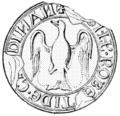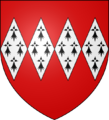Feudal barony of Cardinham facts for kids
The Feudal Barony of Cardinham was one of the three main land areas in Cornwall, England, that were controlled by powerful lords during the Middle Ages. Its main headquarters, or caput, was at Old Cardinham Castle in Cornwall.
In more recent times, the title of the Barony was held by the Vivian family. In 1995, Brigadier Nicholas Vivian, the 6th Baron Vivian, passed the title to John Anthony Vincent. After Mr. Vincent's death in 2018, the Barony was transferred to an American citizen in 2019.
Contents
History of the Cardinham Barony
The area known as Cardinham (or Care Dynham) isn't mentioned in the famous Domesday Book of 1086. This big survey was ordered by William the Conqueror to record who owned what land in England. It's thought that the name "Cardinham" might have come from a family called de Dynham, who originally came from Dinan in Brittany, France.
Some historians believe that the de Cardinham family might have been connected to the de Dynham family of Hartland, Devon. This is because the Barony later passed from Isolda de Cardinham to the Dynham family. The historian John Leland (who died in 1552) thought that Robert de Cardinan, who founded Tywardreath Priory, was "a certain man from the Dinam family."
Another clue is that the family symbols, or arms, of the two families were very similar. The Cardinan family used a shield with Sable, three lozenges in fesse ermine (black with three diamond shapes in a row, decorated with ermine fur patterns). The Dynham family used Gules, four lozenges in fesse ermine (red with four ermine diamond shapes in a row).
Early Owners of Cardinham
- Richard Fitz Turold (died after 1103-1106): He was an early holder of land in the area.
- William Fitz Richard (died unknown): He was likely Richard's son and heir. He is mentioned in old documents from 1110 and 1130. Some think his daughter became the wife of Reginald, Earl of Cornwall.
- Robert FitzWilliam (died around 1169–1177): Records from 1166 show he held lands that used to belong to Richard FitzTurold. In 1169, he and his son Robert gave a gift to Tywardreath Priory in Cornwall.
- Robert, son of Robert FitzWilliam (died around 1230): After his father died, he paid a large "feudal relief" in Devon. This was a payment made to the king when someone inherited land. In 1194, he didn't have to pay "scutage" on 71 "knight's fees." A knight's fee was enough land to support a knight. His seal showed an eagle displayed and said SIGILL(UM) ROBERTI DE CARDINAN (meaning "seal of Robert de Cardinan").
- Andrew de Cardinan (died 1252-1254): He was Robert's son and heir. He had a daughter named Isolda de Cardinan, who became his only heir.
The Dynham Family Takes Over
- Isolda de Cardinan (died after 1301): She was the sole heir of the Barony of Cardinham. She first married Thomas de Tracy. Before Thomas died, she gave away her manors. Later, she married William de Ferrers.
- Oliver de Dinham, 1st Baron Dynham (1234–1299): Oliver was from Hartland, Devon and Nutwell. Isolda de Cardinham gave him the Barony of Cardinham sometime before 1270. In 1270, another person tried to claim the Barony, but Oliver's claim was successful. His title as Baron was not passed down automatically to his children.
- Joce de Dynham (1273–1301): Oliver's son and heir.
- John Dynham (1295–1332): Joce's son.
- John Dynham (1318–1383): Son of the previous John.
- Sir John Dinham (1359–1428): His statue can still be seen in St Mary's Church, Kingskerswell.
- Sir John Dinham (1406–1458): Son of the previous Sir John.
- John Dynham, 1st Baron Dynham (around 1434 – 1501): He was called to attend important meetings of Parliament by Kings Edward IV and Henry VII. The invitations were addressed to Johanni Dynham de Care Dynham, which meant John Dynham of Cardinham. He became known as Baron Dynham. He died without any sons, so his sisters' children became his heirs.
Images for kids



